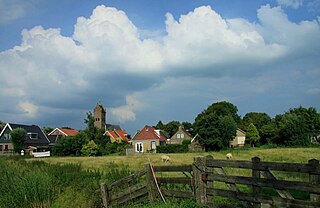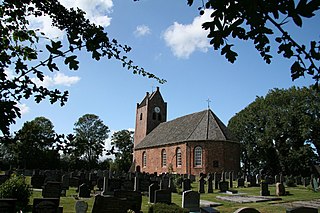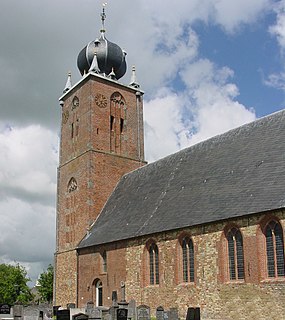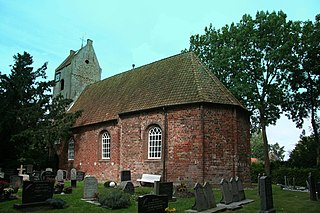| Protestant church of Oudega Saint Agnes church | |
|---|---|
Church of Oudega | |
| 53°07′31″N6°00′03″E / 53.1253°N 6.0009°E Coordinates: 53°07′31″N6°00′03″E / 53.1253°N 6.0009°E | |
| History | |
| Dedication | Before the Reformation, to Saint Agnes |
| Specifications | |
| Materials | Tuffstone |
The Protestant church of Oudega or Saint Agatha church [1] [2] is a religious building in Oudega, Netherlands, one of the many medieval churches in Friesland.

The Netherlands is a country located mainly in Northwestern Europe. The European portion of the Netherlands consists of twelve separate provinces that border Germany to the east, Belgium to the south, and the North Sea to the northwest, with maritime borders in the North Sea with Belgium, Germany and the United Kingdom. Together with three island territories in the Caribbean Sea—Bonaire, Sint Eustatius and Saba— it forms a constituent country of the Kingdom of the Netherlands. The official language is Dutch, but a secondary official language in the province of Friesland is West Frisian.

Friesland, also historically known as Frisia, is a province of the Netherlands located in the northern part of the country. It is situated west of Groningen, northwest of Drenthe and Overijssel, north of Flevoland, northeast of North Holland, and south of the Wadden Sea. In 2015, the province had a population of 646,092 and a total area of 5,100 km2 (2,000 sq mi).
The Romanesque church was built in the early 12th century out of tuffstone and has a tower from c. 1250. [2] In the 14th century the church was lengthened with a straight closed choir. Most of the building is of tufa, but the Gothic former northern entrance is of brick.

Tuff, also known as volcanic tuff, is a type of rock made of volcanic ash ejected from a vent during a volcanic eruption. Following ejection and deposition, the ash is compacted into a solid rock in a process called consolidation. Tuff is sometimes erroneously called "tufa", particularly when used as construction material, but properly speaking, tufa is a limestone precipitated from groundwater. Rock that contains greater than 50% tuff is considered tuffaceous.
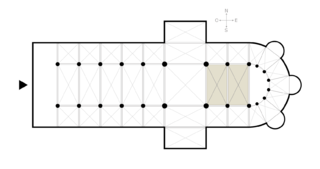
A choir, also sometimes called quire, is the area of a church or cathedral that provides seating for the clergy and church choir. It is in the western part of the chancel, between the nave and the sanctuary, which houses the altar and Church tabernacle. In larger medieval churches it contained choir-stalls, seating aligned with the side of the church, so at right-angles to the seating for the congregation in the nave. Smaller medieval churches may not have a choir in the architectural sense at all, and they are often lacking in churches built by all denominations after the Protestant Reformation, though the Gothic Revival revived them as a distinct feature.

Tufa is a variety of limestone formed when carbonate minerals precipitate out of ambient temperature water. Geothermally heated hot springs sometimes produce similar carbonate deposits known as travertine. Tufa is sometimes referred to as (meteogene) travertine. It should not be confused with hot spring (thermogene) travertine. Tufa, which is calcareous, should not be confused with tuff, a porous volcanic rock with a similar etymology that is sometimes also called "tufa".
The monumental Pipe organ was built in 1875 by L. van Dam & Zn. from Leeuwarden and expanded by Bakker & Timmenga in 1922. [2]

The pipe organ is a musical instrument that produces sound by driving pressurized air through the organ pipes selected via a keyboard. Because each pipe produces a single pitch, the pipes are provided in sets called ranks, each of which has a common timbre and volume throughout the keyboard compass. Most organs have multiple ranks of pipes of differing timbre, pitch, and volume that the player can employ singly or in combination through the use of controls called stops.

Leeuwarden, Stadsfries: Liwwadden) is a city and municipality in Friesland in the Netherlands. It is the provincial capital and seat of the States of Friesland. The municipality has a population of 122,293.
The church is located on the Buorren 1 [3] and was once a Roman Catholic church dedicated to Saint Agnes but became a Protestant church after the Protestant reformation. It is listed as a Rijksmonument, number 33989 and is rated with a very high historical value. [4]

Agnes of Rome is a virgin martyr, venerated as a saint in the Roman Catholic Church, Eastern Orthodox Church, the Anglican Communion, and Lutheranism. She is one of seven women who, along with the Blessed Virgin, are commemorated by name in the Canon of the Mass.

A rijksmonument is a national heritage site of the Netherlands, listed by the agency Rijksdienst voor het Cultureel Erfgoed (RCE) acting for the Dutch Ministry of Education, Culture and Science.




